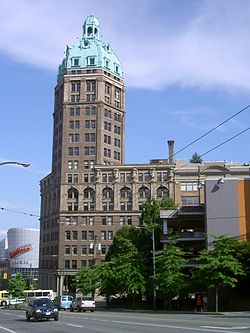Sun Tower
| Sun Tower | |
|---|---|
 |
|
| Former names | World Building |
| General information | |
| Type | Commercial offices |
| Location | 128 West Pender Street Vancouver, British Columbia |
| Coordinates | 49°16′52″N 123°06′30″W / 49.2810°N 123.1084°WCoordinates: 49°16′52″N 123°06′30″W / 49.2810°N 123.1084°W |
| Construction started | 1911 |
| Completed | 1912 |
| Height | |
| Roof | 82.34 m (270.1 ft) |
| Technical details | |
| Floor area | 6,357 m2 (68,430 sq ft) |
| Lifts/elevators | 3 |
| Design and construction | |
| Architect | William Tuff Whiteway |
| References | |
The Sun Tower is a 17 storey 82 m (269 ft) Beaux-Arts building at 128 West Pender Street in Vancouver, British Columbia. It is known for its faux-patina steel dome painted to imitate copper cladding. Nine nude muses, the "nine maidens" supporting the cornice line can be seen. The terracotta for this building, including the ladies, was made in Tamworth, Staffordshire, England by Gibbs and Canning Limited.
The Sun Tower was commissioned by L. D. Taylor to house his newspaper, The Vancouver World. The intention was that the building would be visible throughout the World's circulation area as the tallest building in the city. John Coughland and Sons of Vancouver had 1,250 tons of steel fabricated for construction.
When it was completed in 1912, it was called the World Building and was the tallest building in the British Empire at 82 m (269 ft), surpassing the previous record-holder, the Dominion Building located just around the corner. For one year, it was the tallest building in the British Empire until Toronto's 85 metre Canadian Pacific Building opened in 1913. In 1918, droves of Vancouverites turned out to watch as Harry Gardiner, the "Human Fly", scaled the outside of the building. When The Vancouver Sun bought the building in 1937, it was renamed. Although The Sun newspaper has long since relocated, first to South Granville then to Granville Square, the building has retained the name.
...
Wikipedia
